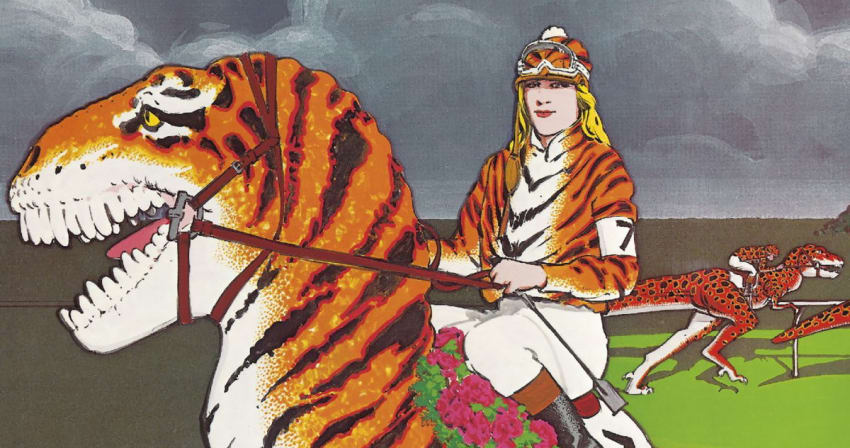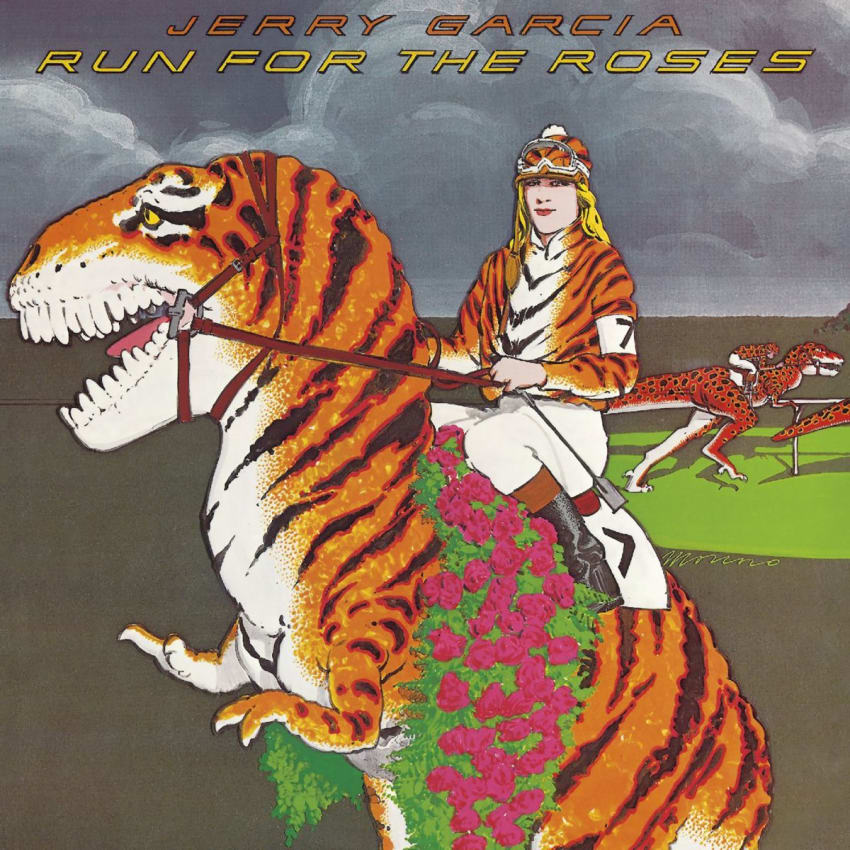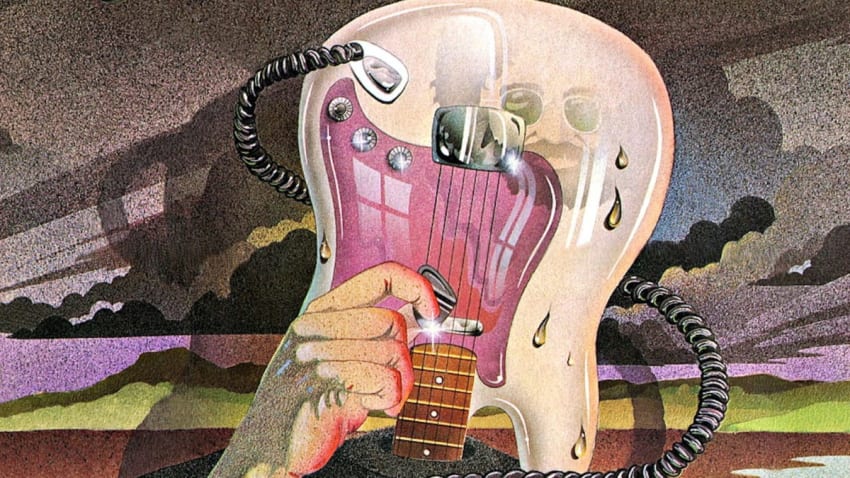Days Between Deep Dive: Jerry Garcia’s Solo Album ‘Run For The Roses’
By Andy Kahn Aug 7, 2020 • 11:18 am PDT

Grateful Dead guitarist Jerry Garcia was born on August 1, 1942 and died on August 9, 1995 at the age of 53. For 25 years, the “Days Between” Garcia’s birthday and the anniversary of his untimely death have been an annual period of reflection and admiration for the legendary musician’s career. This week JamBase honors the Days Between with daily deep dives into Jerry’s five solo studio albums, concluding with today’s look at Jerry Garcia’s 1982 album, Run For The Roses.
Days Between Deep Dives
It was four years between the release of Run For The Roses and Garcia’s previous solo album Cats Under The Stars, which was the lone record credited to the Jerry Garcia Band. The time between releases was double the usual two-year span established in 1972 with Jerry’s solo debut Garcia and continued with 1974’s Compliments, 1976’s Reflections and the aforementioned 1978 LP, Cats Under The Stars.
Mostly thought of for his live performances, Garcia’s studio productivity in the years between the release of Garcia and Run For The Roses is extensive. With the Grateful Dead, who did not tour from late-1974 through mid-1976, Garcia recorded and released Wake Of The Flood (1973), From the Mars Hotel (1974), Blues For Allah (1975), Terrapin Station (1977), Shakedown Street (1978) and Go To Heaven (1980).
Advertisement
Jerry’s 1970s and early-1980s studio work also includes appearing on his Dead band mates’ 1972 solo albums: Bob Weir’s Ace and Mickey Hart’s Rolling Thunder. Garcia contributed to his writing partner, lyricist Robert Hunter’s solo albums, Tales Of The Great Rum Runners (1974) and Tiger Rose (1975). Jerry played on Grateful Dead keyboardist Keith Godchaux and vocalist Donna Jean Godchaux’s self-titled album Keith and Donna Godchaux (1975) and on Dead associate Ned Lagin’s album Seastones (1975).
That time frame included Garcia playing banjo on the self-titled debut album (1975) by the all-star bluegrass ensemble, Old & In The Way. Garcia also contributed to recordings by David Crosby, Stephen Stills, Graham Nash, Link Wray, David Bromberg, Jefferson Airplane, Peter Rowan and several others.
Immediately preceding the release of Garcia, were the Grateful Dead’s pair of 1970 studio albums, Workingman’s Dead and American Beauty, as well as Garcia’s album with keyboardist Howard Wales, Hooteroll? (1971). Jerry was also a member of The New Riders Of The Purple Sage for a few years and contributed pedal steel guitar to their self-titled debut album (1971).
It’s clear from that era’s discography that Garcia spent plenty of time in the studio when he was not touring with the Grateful Dead (which should be noted included the band’s legendary Europe 1972 tour and trip to Egypt in 1978). The ‘72-’82 timeframe also saw Garcia performing live with a number of solo projects, including shows with Wales. Keyboardist Merl Saunders further established a lasting musical relationship with Garcia at that time, participating in co-bills and as a member of Jerry’s short-lived, side bands Legion Of Mary and Reconstruction. Part of 1974 was spent by Garcia playing a run of shows with the also short-lived Great American String Band. The first shows billed as the Jerry Garcia Band took place in 1975. Many JGB tours and personnel changes followed over the subsequent years, beyond the release of Run For The Roses through Garcia’s death in 1995.
Advertisement
The November 1982 release of Run For The Roses on Arista Records was the final solo album Jerry Garcia released. He and the Grateful Dead returned to the studio for their well-received 1987 album In The Dark and their final studio LP, 1989’s Built To Last. Garcia’s studio output continued in 1991 with the first of a handful of albums recorded with his Old & In The Way band mate and longtime friend, David Grisman.
Another longtime friend and Old & In The Way band mate (and in many other Garcia projects), bassist John Kahn was intimately involved with recording Run For The Roses, just as he had been on Jerry’s four prior solo LPs. Kahn, who co-produced the record with Garcia, was one of a few familiar faces recruited for Run For The Roses and played bass on all seven tracks.
Drummer Ron Tutt, who notably backed Elvis Presely, came back for the Run For The Roses recording sessions. Tutt contributed to Compliments, Reflections and Cats Under The Stars and was the original Jerry Garcia Band drummer when they debuted in ‘75. Tutt left JGB in ‘78 before the tour in support of Cats. He played on all of the songs on Run For The Roses, which was mostly made at the Grateful Dead’s rehearsal space/pseudo-converted recording studio Club Front in San Rafael, California — the same location where Cats was recorded, partly on Tutt’s suggestion.
Recording engineers Bob Matthews and Betty Cantor-Jackson, who began working with Garcia and the Grateful Dead in the 1960s and contributed to Garcia and Cats Under The Stars, were also brought back for Run For The Roses. Cantor-Jackson handled the basic recording, while Matthews was in charge of overdubbing and mixing the record.
Victor Moscoso, who designed the Compliments cover, created the Run For The Roses artwork, depicting jockeys in a race riding tiger-striped and leopard-spotted dinosaurs. Garcia spoke about Moscoso’s Run For The Roses artwork in a 1982 interview on San Francisco television program Don Bleu’s Weekend:
Garcia: Victor Moscoso, the artist who executed that cover, is a guy who’s been fond of dinosaurs. And I certainly like dinosaurs. And then there’s that undercurrent of dinosaurs in the rock context, you know. Which is fitting, I guess.
I guess I can think of myself as a dinosaur if I try, you know.

As noted above, Run For The Roses was mostly recorded at Club Front as five of the seven songs on the album came from sessions held there in late-1981. Two songs were outtakes from the February 1974 sessions at Devonshire Studios in Los Angeles that yielded Compliments. Those tracks, covers of The Beatles’ “I Saw Her Standing There” and Clyde McPhatter’s “Without Love,” were recorded by Ron Malo with Matthews handling overdubs and mixing. “I Saw Her Standing There” was the B-side of The Beatles’ 1963 single “I Want to Hold Your Hand,” the legendary band’s first release on Capitol Records. Written by Danny Small, McPhatter’s version of “Without Love (There Is Nothing)” — as it is correctly titled — was released in 1957. Vocalist Tom Jones issued a popular cover in 1970.
“I Saw Her Standing There” was tracked by Garcia, Kahn, Tutt and session keyboardist Michael O’Martian on clavinet. The same group (with O’Martian in piano) is credited on “Without Love,” along with Roger Neuman on trumpet and Jerry’s longtime associate Merl Saunders on organ. Saunders had regularly performed in various groups with Garcia throughout the 1970s, including informal jam sessions at the Matrix in San Francisco and with Legion Of Mary. At the time of the 1982 release of Run For The Roses, Garcia had not shared the stage with Saunders since a run of shows in 1979 with Reconstruction. A few years after Run For The Roses came out, Merl was back by Jerry’s side in 1986 helping the latter recover and relearn to play music after nearly dying from a diabetic coma.
The other cover on Run For The Roses is the album-closing take on Bob Dylan’s classic “Knockin’ On Heaven’s Door.” Over the years, the Jerry Garcia Band covered a few reggae musicians, performing songs by Jimmy Cliff, Bob Marley and Peter Tosh. While Dylan is far from a reggae artist, Garcia nonetheless gave “Knockin’ On Heaven’s Door” a strong reggae vibe on the Run For The Roses recording. Kahn — who played bass, clavinet, guitar and synthesizers — was also credited with the reggae arrangement of the song that was written for Dylan’s 1973 soundtrack album for the film, Pat Garrett And Billy The Kid.
Advertisement
Garcia and his career-long writing partner, lyricist Robert Hunter, co-wrote the album-opening title track, “Run For The Roses.” The legendary songwriting pair also wrote “Valerie.” Garcia, Hunter and Kahn were credited with co-writing “Midnight Getaway,” while Hunter and Kahn (who wrote the only Compliments original “Midnight Town” and the Cats track “Love In The Afternoon”) were co-authors of “Leave The Little Girl Alone.”
“Run For The Roses” was not only the first song on the album, but it was also the first Garcia solo track to feature keyboardist Melvin Seals. Seals played organ on the title track, the other three originals and the “Knockin’ On Heaven’s Door” cover. Seals made his live JGB debut on January 22, 1981 at the Keystone in Palo Alto, California and went on to become the longest-tenured keyboardist in the band, whose legacy he continues to honor today. Seals’ connection to Garcia stemmed from the former’s work with Maria Muldaur, a vocalist who was in a relationship with Kahn in the 1970s. Muldaur, who had hit in 1973 with “Midnight At The Oasis,” contributed backing vocals on Compliments and Cats Under The Stars.
Seals discussed first meeting Garcia on The JamBase Podcast:
Seals: When I got with Jerry, I was just recently out of working with Elvin Bishop. And when I worked with Elvin Bishop, I did some work with Maria Muldaur. Her boyfriend was John Kahn, bass player of Jerry Garcia Band. And so the interesting thing, I was very involved with the church. I had a gospel record company. I had a gospel label producing a lot of gospel music, it was just in me. And so, you know, I was very close to the church and what we were doing there.
And I got with the Jerry Garcia Band through John Kahn. He did some work, played with Maria when I was working with Maria, and he was just paying attention to me. And one day he came up and said, “Man, would you be interested in playing in another band?” As a musician, you always keep the door open. I didn’t even know who he was talking about. He never said anything. One day, I get a phone call, “Hey, you up for doing some gigs this weekend?” or I think it was rehearsal this weekend and the gigs next weekend. And yeah, I was available. And so, we’re going to rehearse, he gave me an address and told me what time and I was trying to be on time to give a good representation, you know?
So I got there before everybody else. And the caretaker of the building let me in, they were expecting me. So I walk in and I’m looking around, the first thing I’m looking around, and I see all these logos. Now, I’m not familiar with the Grateful Dead. I knew their name. Wasn’t a Deadhead. OK? I know their names because, when one would have a birthday Channel 7 would say “Today’s Mickey Hart’s birthday.” Or you’d hear the trouble that was caused when they would play New Year’s in Oakland, the scene that was going on. That’s all I knew. Didn’t know Jerry, anybody else.
I walk in and I see these backdrops, logos. It was a little hard to process because I’m a church boy and all these logos were skeletons. One with a violin in his hand, one skeleton with a rose in his head and just — skeletons. Not to put a bad drift on things, but wasn’t too long ago that massacre happened with Jim Jones, the cult. And so I’m walking in and I’m looking at this, I know nothing, but I’m looking around and I don’t know what’s going on, you know? And so it kinda was a little scary for me not knowing this was their logos. So I was pretty scared, you know, joining.
So anyhow, I do this, I’m looking around, I see all this stuff then comes in all the musicians. They all came in at one time: John Kahn, Greg Errico on drums, Jerry Garcia, Jimmy Warren on keyboard and two background singers and then some side people …
We go over and I get on the organ and we do three songs. We do, “How Sweet It Is,” “The Harder They Come” and there was another Motown song [“Second That Emotion”] … And the guy on guitar says to me, “You play some pretty good organ.” And I say back, “You play some pretty good guitar,” and they’re just laughing because everybody knew I didn’t have a clue. I had no idea. And they just really welcomed that because that was so different from everybody else trying to get the gig and trying to take pictures and utilize the situation. I had no idea. I didn’t care. So I quickly found out, started learning as we did the first set of gigs over at the Keystone I believe it was, this is Jerry Garcia, he’s with the Grateful Dead.
Still the whole big picture wasn’t there, but I’m getting a glimpse of, “Oh, this is that guy.” But I had no idea what I was potentially getting into and where it could have went, and where it went is why I’m able to work today. Through the years of playing with Jerry, he gave me some kudos. He said I was the guy that he was looking for and he even gave me a name. He called me master of the universe. With his fans, Jerry loving me meant his fans loved me.
Seals mentioned fellow keyboardist Jimmy Warren was at that first rehearsal with Garcia, and his piano playing appears on “Run For The Roses,” “Midnight Getaway,” “Leave The Little Girl Alone” and “Valerie.” Warren’s tenure with the Jerry Garcia Band lasted from January 1981 through June 1982. Little is known about Warren, who seems to have stopped playing professionally after his exit from JGB. The excellent Lost Live Dead site dug into Warren’s past, finding his pre-JGB membership in the Marin County-based group Wet Nurse, whose personnel included guitarist Ernie Stires and his sister, vocalist Liz Stires. Warren was in a relationship with Liz Stires, who contributed backing vocals on the Run For The Roses recording of “Knockin’ On Heaven’s Door” (along with Julie Stafford).
Lost Live Dead cites an interview Grateful Dead/JGB crew member Steve Parish conducted with author Blair Jackson in which Warren’s questionable involvement with Garcia was probed. Parish described Warren as one of the “‘shadow people’ that walk in and out of the scene of the Grateful Dead,” adding, “Jimmy was something that Jerry and John [Kahn] — they wanted him to play there, and it was for other reasons besides the music. It’s the only time that ever happened. He didn’t last very long, either. To his credit, he tried to fit in and he was a wonderful guy, Jimmy — he was really a good-hearted guy — but he had other problems that were overshadowing him being able to go and be a full-on musician.”
The Jerry Garcia Band would regularly play “Run For The Roses” live between its debut in 1981 and their final shows in 1995. The only other songs on the album that were brought to the live setting were the often-performed “Valerie” and “Knockin’ On Heaven’s Door,” the latter of which also entered the Grateful Dead’s live repertoire in 1987.
Stream Jerry Garcia’s 1982 album, Run For The Roses, plus the bonus tracks discussed here, below:




